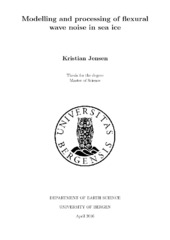| dc.description.abstract | One of the most common problems with seismic data obtained on sea ice is the presence of flexural ice wave noise on the seismic raw data. Flexural wave noise occurs on seismic data acquired on ice in the so-called transition zone between the shoreline and deep sea. As the flexural waves are highly dispersive they are manifested as a broad fan of noise on the seismic data, often having an order of magnitude 40-60 dB higher than reflected signals. In addition, the frequency spectrum of flexural ice waves frequently overlaps with reflected signals, and due the low velocities of flexural waves, spatial aliasing commonly occurs. Thus, flexural waves may be difficult to remove using conventional seismic processing techniques. This study outlines how flexural waves can be modelled and discuss various processing techniques for removing energy related to the flexural waves while preserving the reflected signals as much as possible. Modelling and processing help us to understand how various parameters such as ice temperature and ice thickness affect the flexural wave pattern, which can be important when designing a proper processing work flow. For this study, three primary processing methods have been applied and compared on several datasets: conventional frequency-wave number (f-k) processing, slant-stack (tau-p) processing, and radial trace (RT) transform processing. Modelling reveals that a decrease in ice temperature and/or an increase in ice thickness will increase the phase velocity of the flexural waves whereas the same is true for group velocities at lower frequencies only. Testing of processing work flows indicate that when receivers are densely spaced to better exclude spatial aliasing problems, the best results are obtained with conventional f-k filtering. At larger receiver offsets, however, a combination of tau-p and RT filtering produces the best results on both synthetic and real data. Thus, not one single method will always produce the best result, and different processing approaches may be used depending on the data at hand. | en_US |
